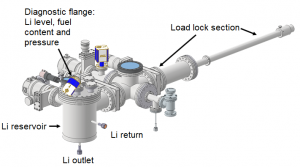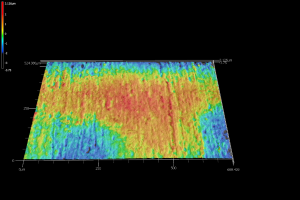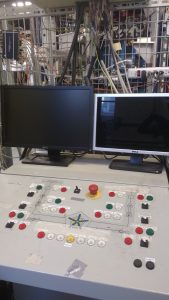The 62nd annual meeting of the American Physical Society-Division of Plasma Physics (APS-DPP) was celebrated remotely, adapted due to the COVID circumstances. These two symposia closed the cycle of scientific events in the 2019 year for CPMI people. Several contributions were presented by the Fusion side of the laboratory. The tutorial invited talk given by Professor Ruzic, titled “Lithium, a way to make fusion energy affordable”, reviewed the basics of energy confinement and fusion performance and how flowing liquid lithium diverters can improve them to make smaller size reactors feasible, also emphasizing in the technologies necessary for the proposed liquid metal solution. The other talk given by D. O’Dea presented the analyses of heat handling capabilities of LiMIT during the EAST experiments. In the simulations, values up to 4.5 MW/m2 were in agreement with the experimental data, also showing improvements in wetting and robustness of the PFC when compared to the previous experiments with FLiLi flat plates. Further analyses to be performed in the higher power discharges with more intense NBI heating are expected to enhance those heat fluxes. Finally, results from the projects with General Fusion and Tokamak Energy companies were presented in two different posters where the divertor plate and liquid lithium loop design for ST40 as well as the studies of the dynamic corrosion for GF were approached.

External elements* of the loop being designed for the testing of the LiMIT divertor module in ST40 Tokamak
Professor Ruzic was awarded with the 2020 AVS Gaede-Langmuir Award during the remotely celebrated 67th Annual Meeting of the American Vacuum Society (AVS) 27-29 October 2020. He gave the opening invited Lecture titled “How Advances in High-Power Magnetron Impulse Sputtering (HiPIMS) can control Ion Energy, Ionization, and have High Deposition Rates”, outlining the research in this area developed at CPMI. Regarding the SBIR project with Micro Cooling Inc., internal meetings with the DOE representative presenting the main plans for the collaborative task between UIUC and the company occured. Last, designs of the crucible and microtrenched samples were conducted in collaboration with UIUC. The laboratory expects to receive samples from the company soon and experimental systems are ready to start studies with the wetting test.
Works in HIDRA continued to begin operation for the Lab classes and planning on conducting experiments with plasmas and lithium sample exposure. Meetings to define the scope of the works for the new research collaboration with GF took place. The proposal contemplates to study the compatibility of advanced coatings with liquid lithium under dynamic erosion/corrosion environment, basic science questions with lead lithium as vapor pressure and segregation as well as ideas involving the use of lithium floating into liquid led lithium are included. Second round of material testing for the company was successfully completed during the complete time scale of the experiment (100 h). Characterization of surface and tensile stress effects analyses are ongoing.

3D microscopy characterization of one of the samples studied in the project with General Fusion
This week Professor Ruzic and a collection of graduate students are attending the 66th AVS Symposium in Columbus, Ohio. Professor Ruzic gave a talk this morning on Compact Surface Wave Plasma Source. His graduate students will also be presenting throughout the week and learning from other experts in the field.
Professor Ruzic and Professor Andruczyk have just finished the ISLA 2019 Conference this week. The International Symposium on Liquid Metals Applications for Fusion just had its 6th event and the University of Illinois at Urbana-Champaign was lucky enough to be its host for the week! Exploring multiple areas of liquid metal research the conference was successful and included trips to both CPMI and Spurlock Museum to show off our campus.
Professor Ruzic is headed to Proec, Croatia for the 10th international iPlasmaNano conference! He will be giving a talk called “Femtosecond Laser Texturing at Multiple Wavelengths” on the 18th. Professor Ruzic will spend the rest of his time listening to other scientists and research presenting about how plasmas make nano structures. And probably head to the beach at some point. http://iplasmanano2019.com/index.php

Above: The HIDRA control station
For the first time since HIDRA arrived at the Center for Plasma-Material Interactions, thousands of amps of current ran through its magnetic coils – all controlled from one place.
HIDRA, the Hybrid Illinois Device for Research and Applications, arrived on site from Germany in late 2014. Since then, students and university staff have worked together under the direction of Professor Daniel Andruczyk to assemble the machine and commission all of its systems. Their efforts led to the successful creation of the first plasma in HIDRA, achieved just over one year ago in April, 2016.
In the past year, work has been done to develop and install a control system so that the entire machine can be run from a single control station. The control software was written by undergraduate student Dan Johnson and implemented with assistance from Quad Plus. Graduate student Rabel Rizkallah and undergraduates Andrew Shone and Zack Jeckell all contributed many long hours of work to prepare the machine for testing the new system.
Last week, the HIDRA team commissioned the control system and successfully ran thousands of amps through the machine’s magnetic coils. “This was really a major milestone”, according to CPMI director Professor David Ruzic. “We are fully capable now of running any current.”
Having full computer control over the magnets makes it possible for the operator to program in exactly how much current they want to flow through the coils and for exactly how long. This flexibility opens the door to running world-class experiments on HIDRA, and will support the team’s collaborations with the Princeton Plasma Physics Laboratory and the EAST experiment in China.
CPMI’s own Matthew Parsons was featured in Science Magazine this week! Young scientists from a variety of fields were asked to address the issue of what changes are required to preserve Earth’s ecosystems and biodiversity, specifically in their field. Matt’s response was featured: “To protect our environment, we must replace fossil fuels with cleaner energy options. One possibility, nuclear fusion, produces energy when hot hydrogen nuclei collide to form helium. At such high temperatures, hydrogen becomes
a new state of matter: plasma. Plasma physicists and engineers around the world are working together to learn how to con- trol plasmas, so that the energy produced in fusion reactions can be used to create electricity.” The entire article can be found here! Congratulations, Matt!
CPMI Director Professor Ruzic and graduate students Dren Qerimi and Gianluca Panici were in San Jose this past week at the SPIE Advanced Lithography Conference. While at this conference, Gianluca was featured in an oral presentation on his poster on Study of ion-enhanced Sn removal by surface wave plasma for collector cleaning!
Postdoctoral search now OPEN! The Center for Plasma Material interactions (CPMI) at the University of Illinois at Urbana Champaign is looking to fill in a position at the post-doctoral research associate level, who will work on research areas relevant to plasma material interactions for several applications.The Center for Plasma-Material Interactions currently has 12 graduate students, and over 20 undergraduate researchers. In particular, we are looking for expertise in the field of atmospheric pressure plasmas for material modification/coatings.
More information can be found here PostDoc Illinois Ruzic 2017
Congratulations to Peter Fiflis for being named the 2017 Ross J. Martin Award recipient! The college-wide selection honors an outstanding graduate student for their research achievements – both in quality and magnitude. More information regarding the award can be found at this link. Congratulations, Peter, on a very well deserved award!


